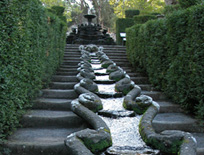With Your Own Eyes

 If you want to gain a full appreciation for classic fountains, pools or waterfeatures, you really do need to pack your bags: Seeing their beauty, power and subtlety at first hand gives us the opportunity to observe scale, recognize proportions, understand textures, hear the sounds they make (or don’t make) — and perhaps most important, see these fascinating works in their physical and historical contexts.
If you want to gain a full appreciation for classic fountains, pools or waterfeatures, you really do need to pack your bags: Seeing their beauty, power and subtlety at first hand gives us the opportunity to observe scale, recognize proportions, understand textures, hear the sounds they make (or don’t make) — and perhaps most important, see these fascinating works in their physical and historical contexts.
In this new series, I’ll be sharing some installations I’ve particularly enjoyed seeing in person — all by way of encouraging you to get out on your own to partake of the protean charms of some of what I see as the world’s greatest watershapes.
Let’s begin with a visit to Italy, where you’ll find a truly amazing class of watershapes that fall under the general heading of “water chains” — lots of examples of which were produced during the Italian Renaissance.
For my travel dollar, there’s no finer or better-preserved Italian Renaissance garden complex than the one you’ll find at Villa Lante, which sits just outside Viterbo in the small Tuscan town of Bagnaia.
Near the center of the lavish 16th-century estate, you’ll find the Catena d’Acqua (“water stair”), a flow that connects the upper and middle portions of the landscape. As you ascend or descend the adjacent staircases, water cascades down the center along a sculptural element that was inspired by claws of a crayfish, part of the family crest of the villa’s ambitious owner.
Only a handful of these classic water chains are still functioning. On its own, this one has served as inspiration for countless modern replicas and variations. It’s easy to understand why: These watershapes are wonderfully versatile and fit into just about any design scheme, from classic to contemporary. Indeed, they’re so much a part of modern watershaping that they’re now found on various scales and with various materials in a huge number of cityscapes, especially in places where people flow from one level or environment to another.
This concept of people moving alongside water is important symbolically and psychologically. The flow puts people at ease as they ascend or descend — a pleasant and even soothing distraction in the midst of what can be a real workout.
In my own experience at Villa Lante, I also found myself appreciating the simple elegance of the design while standing still at its top or bottom. But I walked up and down the staircases more times than I can count and took literally hundreds of photographs, often from exactly the same places over and over again as new thoughts struck me with each passing.
And, of course, it’s not just the Catena d’Acqua that impresses. Italian Renaissance gardens are mesmerizing, and those at Villa Lante are so well preserved that you can almost hear the sounds of a 16th-century party echoing across the grounds.
So don’t even think about sidestepping Viterbo and the Villa Lante when you plan your wine tour of Tuscany. It’s an utterly essential stopping place for anyone who wants to experience the grand design tradition on display there.
One caveat: As is true in many old European towns, hiking is part of the deal. Villa Lante sits at the highest point in Bagnaia, and the climb to the top carries you past the villa’s foundations, giving you a sense of just how substantial the place is before you even get there.
One advantage of the remote setting is that it isn’t packed with tourists. During my visit, I was almost completely alone as I wandered through the estate’s garden acreage, an experience that amplified how removed from time and place I felt while there. In fact, my clothes and camera were the only modern things on hand to ground me in reality.
Very cool, and well worth making a destination.
Mark Holden, founder of Holdenwater in Fullerton, Calif., is a landscape architect, landscape and pool contractor, and educator specializing in watershapes. He is a veteran contributor to WaterShapes magazine.









